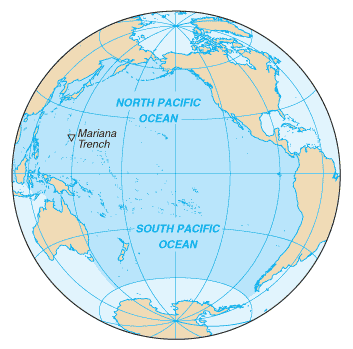Sea Creatures
Whales
|
|
Pacific OceanThe Pacific Ocean is the largest of the world's five oceans Area:total: 155.557 million sq km Natural resources:oil and gas fields, polymetallic nodules, sand and gravel aggregates, placer deposits, fish Environment - current issues: Ports and terminals:Bangkok (Thailand), Hong Kong (China), Kao-hsiung (Taiwan), Los Angeles (US), Manila (Philippines), Pusan (South Korea), San Francisco (US), Seattle (US), Shanghai (China), Singapore, Sydney (Australia), Vladivostok (Russia), Wellington (NZ), Yokohama (Japan) Environment - current issues:Pacific Ocean endangered marine species include the dugong, sea lion, sea otter, seals, turtles, and whales; oil pollution in Philippine Sea and South China Sea The Pacific Ocean is a major contributor to the world economy and particularly to those nations its waters directly touch. It provides low-cost sea transportation between East and West, extensive fishing grounds, offshore oil and gas fields, minerals, and sand and gravel for the construction industry. In 1996, over 60% of the world's fish catch came from the Pacific Ocean. Exploitation of offshore oil and gas reserves is playing an ever-increasing role in the energy supplies of the US, Australia, NZ, China, and Peru. The high cost of recovering offshore oil and gas, combined with the wide swings in world prices for oil since 1985, has led to fluctuations in new drillings. Geography - note:The Pacific Ocean has major chokepoints are the Bering Strait, Panama Canal, Luzon Strait, and the Singapore Strait; the Equator divides the Pacific Ocean into the North Pacific Ocean and the South Pacific Ocean; dotted with low coral islands and rugged volcanic islands in the southwestern Pacific Ocean Transportation - note:Inside Passage offers protected waters from southeast Alaska to Puget Sound (Washington state); the International Maritime Bureau reports the territorial waters of littoral states and offshore waters in the South China Sea as high risk for piracy and armed robbery against ships; numerous commercial vessels have been attacked and hijacked both at anchor and while underway; hijacked vessels are often disguised and cargoes stolen; crew and passengers are often held for ransom, murdered, or cast adrift.
Photographer's amazing image reveals 'tornado' of schooling fishBy: Pete Thomas, GrindTV.com An image showing a photographer standing on the sea floor, dwarfed by an enormous and towering "tornado" of fish has been an extremely popular share item on Facebook for weeks. Now the details behind the image are being shared by Mission Blue. The photographer is a scientist named Octavio Aburto, and the location was Cabo Pulmo National Park, a vast marine reserve in Mexico's Sea of Cortez, north of Cabo San Lucas on Baja California's tip. (read more) |

The Pacific Ocean is the largest of the world's five oceans (followed by the Atlantic Ocean, Indian Ocean, Southern Ocean, and Arctic Ocean). Strategically important access waterways include the La Perouse, Tsugaru, Tsushima, Taiwan, Singapore, and Torres Straits. The decision by the International Hydrographic Organization in the spring of 2000 to delimit a fifth ocean, the Southern Ocean, removed the portion of the Pacific Ocean south of 60 degrees south. Mariana Trench, depression in the floor of the Pacific Ocean, the deepest seafloor depression in the world. It is located just east of the Mariana Islands in the western part of the ocean basin. The Mariana Trench is an arc-shaped valley extending generally northeast to southwest for 2,550 km (1,580 mi); its average width is 70 km (40 mi). The Mariana is one of many deepwater ocean trenches formed by the geologic process of subduction Natural resources:The Pacific Ocean has oil and gas fields, polymetallic nodules, sand and gravel aggregates, placer deposits, fish Natural hazards:The Pacific Ocean is surrounded by a zone of violent volcanic and earthquake activity sometimes referred to as the "Pacific Ring of Fire"; subject to tropical cyclones (typhoons) in southeast and east Asia from May to December (most frequent from July to October); tropical cyclones (hurricanes) may form south of Mexico and strike Central America and Mexico from June to October (most common in August and September); cyclical El Nino/La Nina phenomenon occurs in the equatorial Pacific, influencing weather in the Western Hemisphere and the western Pacific; ships subject to superstructure icing in extreme north from October to May; persistent fog in the northern Pacific can be a maritime hazard from June to December Twice thw size of Texas
Ban the use of plastic before it's too late or maybe it is alreadyShould plastic bags be banned? All the Yes points
Source: debatewise.org |